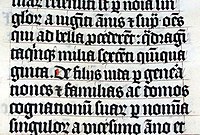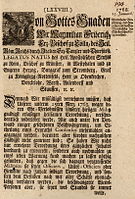Tironic notes
The Tironic notes are a Roman shorthand system that was developed in the first century BC by Marcus Tullius Tiro , Cicero's private secretary , for taking down speeches and court hearings and comprised around 4,000 characters.
The system of symbols consists of greatly reduced capital letters , some of italics . The capitalized main characters (word characters) stand for a whole word and are supplemented by small additional characters ( auxiliary, titulus ) that express the inflected endings.
history
Antiquity

Tiro instructed young senators in his grades, and they drew it on December 5, 63 BC. The accusation speech against Catiline after the procedure of the writing round .
The Tironic notes were an important part of writing training in ancient times. By the end of the Roman Empire, the treasure trove of symbols had more than doubled. In the Commentarii Notarum Tironianarum , the 5th century collection of Tironian notes, which was the main source of their knowledge in the Middle Ages, 13,000 characters can be found.
middle Ages
In the Franconian Empire , the Tironic notes were used in particular by the writers of the Franconian rulers. However, they have only been used sporadically since the 10th century. Individual characters have passed into the general treasure trove of abbreviations , which were mainly used to save space. The notes were too difficult and extensive for everyday use. Over 10,000 different notes are known. In Germany, there are particularly few traces of their use from the high and late Middle Ages .
In the Middle Ages, the Tironic notes were used to correct, excerpt and comment on manuscripts. Some Tironic notes were used throughout Western Europe until the 17th century.
exploration
In the 19th and first half of the 20th century, the Tironic notes were researched in particular by Wilhelm Schmitz , Maurice Jusselin , Arthur Mentz and Michael Tangl .
Tironic Et
use

The Tironic Et is an abbreviation for Latin et (German "and"). This ⁊ is still used today as the only Tironic note, in Irish and Scottish Gaelic instead of “& ” (see second picture on the right).
In the German Fraktur the Tironic Et was used in the abbreviation ⁊ c until well into the 19th century . (= etc. ) used. The round r of the broken fonts is similar to the ⁊ in some fonts , but less in other fonts (see first picture below). In the absence of ⁊ in a brief the round r was often used as a substitute for ⁊ used (see second image below). As a result, the Tironic Et is occasionally confused with a round r.
Norms
Unicode : U + 204A tironian sign et in the block general punctuation .
The keyboard standard ISO / IEC 9995-3 : 2010 specifies the key combination for entering the Tironic Et, which appears as followed by on the German keyboard layout . This input option is therefore also available in the German keyboard layout T3 according to the German standard DIN 2137-1 : 2012-06. Gruppenumschaltung ⇨^
Examples
Web links
- TypoAkademie Munich: Tironic notes
- Eberhard Henke: About tironic notes. Monumenta Germaniae Historica , archived from the original on February 12, 2006 ; accessed on May 26, 2019 . Manuscript B 16 in the library of the Monumenta Germaniae Historica, ca.1960
- Martin Hellmann: Hypertext Lexicon of the Tironic Notes
- Stephan Bender: History of the Tironic shorthand characters
- Tironic notes in the Carolingian era (PDF file; 14 kB)
Individual evidence
-
↑
- Maurice Jusselin: Mentions tironiennes des diplômes carolingiens utiles à la diplomatique, Bull. Phil. et hist. ### (1951/2) 11-29
- Maurice Jusselin: Notes tironiennes de quelques diplômes carolingiens, in: Bibliothèque de l'Ecole des Chartes, CIX (1949), pp. 193–197.
- Maurice Jusselin: Questions tironiennes à propos des 'Diplomata Karolinorum', in: Bibliothèque de l'Ecole des Chartes, C (1939), pp. 5-7.
- Maurice Jusselin: Notes Tironiennes dans un diplôme de Charles le Chauve du 25 juillet 864, Le Moyen Age 41 (= 3. sér. 2 (1931) 3f).
- Maurice Jusselin: List chronologique et lecture des mentions en notes tironiennes dans les diplômes de Charles le Chauve, Le Moyen Age 39 (1929) 217–232
- Maurice Jusselin: La Chancellerie de Charles le Chauve d'après les notes Tironiennes, in: Le Moyen Age 33 (1922), pp. 18ff.
- Maurice Jusselin: La transmission des ordres à la chancellerie mérovingienne d'après les souscriptions en notes tironiennes, BECh 74 (1913) 67–73
- Maurice Jusselin: La garde et l'usage du sceau dans les chancelleries carolingiennes d'après les notes tironiennes. In: Mélanges offerts à M. Émile Châtelain, Paris 1910 (ND Geneva 1976), pp. 35–41
- Maurice Jusselin: Tironiana. Le prétendu scribe d'un acte du synode de Pitres du 20 June 86 r, in: Bibliothèque de l'Ec-ole des Chartes, LXVIII (1907), pp. 668–669.
- Maurice Jusselin: Notes tironiennes dans les diplômes mérovingiens, in: BECh 68 (1907), pp. 481-508.
- Maurice Jusselin: The decline of the Tironic notes at the end of the 11th century, in: Archive for Senography, Berlin 1906.
- Maurice Jusselin: Notes tironiennes dans les diplômes, in: Bibliothèque de l'Ecole des Chartes, LXVI (1905), pp. 361-663.
-
↑
- Arthur Mentz: Gabelsberger und die Tironische Noten, in: ders., Franz Xaver Gabelsberger, died January 4, 1849, Wolfenbüttel 1948.
- Arthur Mentz: Three homilies from the Carolingian period in Tironic notes, Bayreuth 1942.
- Arthur Mentz: The Tironic Notes. A history of Roman shorthand, part 2: Continuation of vol. XVI, pp. 287–384, with 2 panels and many illustrations in the text, in: AUF 17 (1942), pp. 155ff.
- Arthur Mentz: The Tironic Notes. A history of Roman shorthand, part 1: With 1 panel, in: AUF 16 (1939), p. 287ff.
- Arthur Mentz: A letter of the 9th century in Tironic notes (panels I, II, III), in: AUF 14 (1936), p. 211ff.
- Arthur Mentz: Contributions to the Tironic Notes, in: AUF 11 (1930), p. 153ff.
- Arthur Mentz: The Tironic Notes in the Gospel of St. Kilian zu Würzburg, (with illustrations p. 13), in: AUF 8 (1923), p. 6ff.
- Arthur Mentz: Contributions to the Tironic Notes in the Middle Ages, in: AUF 6 (1918), p. 1ff .. PDF
- Arthur Mentz: Contributions to the history of the Tironic notes, in: AUF 4 (1912), p. 1ff.
- Arthur Mentz: Contributions (to the history) of the Tironic notes (in the Middle Ages), ON. 4 (1912) 1-38 and 6 (1916/8) 1-18 and 11 (1930) 153-175
- Arthur Mentz: The addition in the Tironic notes. In: Mélanges offerts à M. Émile Châtelain, Paris 1910 (ND Geneva 1976), pp. 501–507
-
↑
- Michael Tangl: The Tironic Notes of Cod. Vat. Regin. lat. 612, NA 39 (1914) 507-509 and Tafel
- Michael Tangl: The tironic notes in the documents of the Carolingians, in: AUF 1 (1908), pp. 97-105.
- Michael Tangl: The draft of an unknown certificate of Charlemagne in Tironic notes, in: MIÖG 21 (1900), pp. 344-350.
- ^ Scottish Parliament translation guidelines. Retrieved November 15, 2019 .
literature
- P. Ladner: Tironic notes . In: Lexicon of the Middle Ages . Volume VIII. Col. 804f.
- Martin Hellmann: Tironic notes from the Carolingian era. Using the example of a Persius commentary from the School of Tours . Hahn, Hannover 2000, ISBN 3-7752-5727-6 , ( Monumenta Germaniae historica studies and texts 27), (At the same time: Heidelberg, Univ., Diss., 1999: The oldest surviving Persius commentary. Written in Tironic notes in the School of Tours ).
- Peter Ganz (Ed.): Tironic notes . Lectures given on the occasion of a working discussion from December 7th to 10th, 1987 in the Herzog August Library. Harrassowitz, Wiesbaden 1990, ISBN 3-447-03104-2 , ( Wolfenbütteler Medieval Studies 1).
- Arthur Mentz: The Tironic Notes. A history of Roman shorthand . In: Archiv für Urkundenforschung 16, 1939, ZDB -ID 212111-6 , pp. 287–384 and 17 (1942), pp. 222–235, (also independent: de Gruyter, Berlin 1944).
- Émile Châtelain: Introduction à la lecture des notes tironiennes . Self-published, Paris 1900, (Also reprinted by Franklin, New York NY 1963, ( Burt Franklin research and source Works Series 62, ZDB -ID 844446-8 )).
- Herbert Boge: Greek Tachygraphy and Tironic Notes. A manual of ancient and medieval shorthand . Akademie-Verlag, Berlin 1973.
- Georg Söldner: The derived verbs in the Tironic notes. Inaugural dissertation . Munich, 1916 (published by Noske, Borna-Leipzig, 1916)
- Lexicons
- Ulrich Friedrich Kopp: Lexicon Tironianum . (Reprint from Kopp's Palaeographia critica 1817 with an afterword and an Alphabetum Tironianum by Bernhard Bischoff ). Zeller, Osnabrück 1965.
- P. Carpentier: Alphabetum Tironianum, see Notas Tironis Explicandi Methodus. Cum pluribus Ludovici Pii Chartis, quae notis iisdem exaratae sunt et hactenus ineditae, ad Historiam et Jurisdictionem cum ecclesiasticam, tum civilem pertinentibus . Guerin, Paris 1747.
- Giorgio Costamagna, Maria Franca Baroni, Luisa Zagni: Notae Tironianae quae in lexicis et in chartis reperiuntur novo discrimine ordinatae . Il Centro di Ricerca, Rome 1983, ( Fonti e studi del corpus Membranarum Italicarum ser. 2: Fonti Medievali 10, ZDB -ID 439669-8 ).




